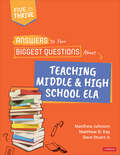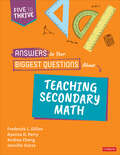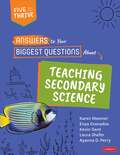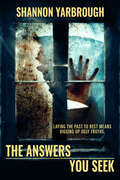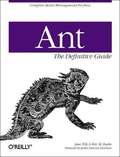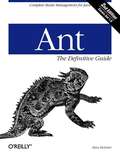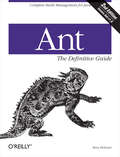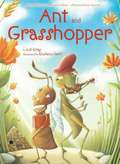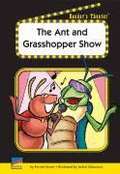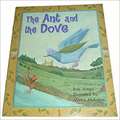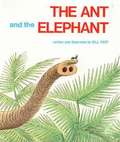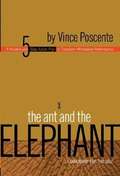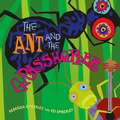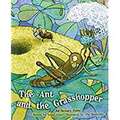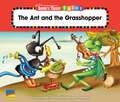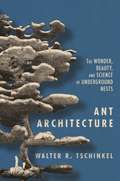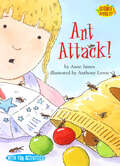- Table View
- List View
Answers to Your Biggest Questions About Teaching Middle and High School ELA: Five to Thrive [series] (Corwin Literacy)
by Matthew Johnson Dave Stuart Matthew R. Kay"Matthew Johnson, Dave Stuart Jr., and Matthew R. Kay have written a book to help navigate the burning questions early career teachers long to understand. From ways to build a community of learners to motivational instruction to feedback that works for students and teachers alike, these inspirational teachers share what it takes to craft a career for the long haul." - Andy Schoenborn, co-author of Creating Confident Writers: For High School, College, and Life Your guide to grow and learn as an ELA teacher! Let’s face it, major shifts over the past decade, including pandemic-related challenges, have rapidly changed our ELA classrooms. New and experienced teachers can benefit from guidance on the fundamentals of what excellent teaching and learning of writing can look like. Friendly and practical, this book is a reminder of the things that matter most. Part of the Five to Thrive series for early-career educators, Answers to Your Biggest Questions About Teaching Middle & High School ELA offers solutions for any teacher who wishes to refresh their practice. Questions and answers are organized into five areas that will help you thrive in your classroom: How do I build a brave, supportive reading and writing community? How do I cultivate motivation? How can I ensure that my feedback and assessment are efficient, effective, and equitable? What does strong ELA instruction look like? How can I keep doing this for my whole career? The authors, all practicing ELA educators, provide solutions to the most urgent challenges teachers face in providing student-centered and efficient instruction. With an emphasis on equity, culturally responsive practice, and intrinsic motivation, the book focuses on the wellbeing of both students and teachers. You’ll find accessible tips for immediate use woven throughout. Strive to be the best ELA educator you can; your students are counting on it!
Answers to Your Biggest Questions About Teaching Secondary Math: Five to Thrive [series] (Corwin Mathematics Series)
by Frederick L. Dillon Ayanna D. Perry Andrea Negrete Cheng Jennifer OutzsLet’s face it, teaching secondary math can be hard. So much about how we teach math today may look and feel different from how we learned it. Teaching math in a student-centered way changes the role of the teacher from one who traditionally "delivers knowledge" to one who fosters thinking. Most importantly, we must ensure our practice gives each and every student the opportunity to learn, grow, and achieve at high levels, while providing opportunities to develop their agency and authority in the classroom which results in a positive math identity. Whether you are a brand new teacher or a veteran, if you find teaching math to be quite the challenge, this is the guide you want by your side. Designed for just-in-time learning and support, this practical resource gives you brief, actionable answers to your most pressing questions about teaching secondary math. Written by four experienced math educators representing diverse experiences, these authors offer the practical advice they wish they received years ago, from lessons they′ve learned over decades of practice, research, coaching, and through collaborating with teams, teachers and colleagues—especially new teachers—every day. Questions and answers are organized into five areas of effort that will help you most thrive in your secondary math classroom: How do I build a positive math community? How do I structure, organize, and manage my math class? How do I engage my students in math? How do I help my students talk about math? How do I know what my students know and move them forward? Woven throughout, you′ll find helpful sidebar notes on fostering identity and agency; access and equity; teaching in different settings; and invaluable resources for deeper learning. The final question—Where do I go from here?— offers guidance for growing your practice over time. Strive to become the best math educator you can be; your students are counting on it! What will be your first step on the journey?
Answers to Your Biggest Questions About Teaching Secondary Math: Five to Thrive [series] (Corwin Mathematics Series)
by Frederick L. Dillon Ayanna D. Perry Andrea Negrete Cheng Jennifer OutzsLet’s face it, teaching secondary math can be hard. So much about how we teach math today may look and feel different from how we learned it. Teaching math in a student-centered way changes the role of the teacher from one who traditionally "delivers knowledge" to one who fosters thinking. Most importantly, we must ensure our practice gives each and every student the opportunity to learn, grow, and achieve at high levels, while providing opportunities to develop their agency and authority in the classroom which results in a positive math identity. Whether you are a brand new teacher or a veteran, if you find teaching math to be quite the challenge, this is the guide you want by your side. Designed for just-in-time learning and support, this practical resource gives you brief, actionable answers to your most pressing questions about teaching secondary math. Written by four experienced math educators representing diverse experiences, these authors offer the practical advice they wish they received years ago, from lessons they′ve learned over decades of practice, research, coaching, and through collaborating with teams, teachers and colleagues—especially new teachers—every day. Questions and answers are organized into five areas of effort that will help you most thrive in your secondary math classroom: How do I build a positive math community? How do I structure, organize, and manage my math class? How do I engage my students in math? How do I help my students talk about math? How do I know what my students know and move them forward? Woven throughout, you′ll find helpful sidebar notes on fostering identity and agency; access and equity; teaching in different settings; and invaluable resources for deeper learning. The final question—Where do I go from here?— offers guidance for growing your practice over time. Strive to become the best math educator you can be; your students are counting on it! What will be your first step on the journey?
Answers to Your Biggest Questions About Teaching Secondary Science: Five to Thrive [series]
by Ayanna D. Perry Karen Mesmer Enya Granados Kevin Gant Laura ShaferYour guide to grow and flourish as a science teacher! The past two decades have seen a paradigm shift in science education, thanks in large part to the Next Generation Science Standards (NGSS), which advocate a move away from procedural lab investigations and direct instruction and toward increased emphasis on reasoning, sensemaking, phenomena exploration, problem solving, and collaboration. Under this new paradigm, students are learning real science as scientists practice it, so that more and more students are actively investigating questions and pursuing solutions of their own making. As part of the Five to Thrive series for early-career educators, this comprehensive guide provides those who are new to teaching science, as well as seasoned teachers looking to enhance their practice, the fundamentals to develop best teaching practices that reflect their students’ experiences and requirements. Written by experienced science educators, Answers to Your Biggest Questions About Teaching Secondary Science provides practical guidance on successful strategies and techniques for teaching science in a way that gives every student the opportunity to learn, grow, and achieve at high levels, while providing opportunities to develop their agency and authority in the classroom, ultimately resulting in a positive science identity. The book is organized around five overarching questions and answers that will help you most thrive in your secondary science classroom: How do I build a positive science community? How do I structure, organize, and manage my science class? How do I engage my students in science? How do I help my students talk about science? How do I know what my students know and how can I use that information to plan and move them forward? The book concludes with a sixth question—Where do I go from here?—that provides guidance for growing your practice over time, including discussions on self-care, advocating for students, and an extensive discussion on growing your professional network. Woven throughout, you′ll find helpful sidebar notes on fostering identity and agency; access and equity; teaching in different settings; and invaluable resources for deeper learning.Strive to become the best science educator you can be; your students are counting on it!
Answers to Your Biggest Questions About Teaching Secondary Science: Five to Thrive [series]
by Ayanna D. Perry Karen Mesmer Enya Granados Kevin Gant Laura ShaferYour guide to grow and flourish as a science teacher! The past two decades have seen a paradigm shift in science education, thanks in large part to the Next Generation Science Standards (NGSS), which advocate a move away from procedural lab investigations and direct instruction and toward increased emphasis on reasoning, sensemaking, phenomena exploration, problem solving, and collaboration. Under this new paradigm, students are learning real science as scientists practice it, so that more and more students are actively investigating questions and pursuing solutions of their own making. As part of the Five to Thrive series for early-career educators, this comprehensive guide provides those who are new to teaching science, as well as seasoned teachers looking to enhance their practice, the fundamentals to develop best teaching practices that reflect their students’ experiences and requirements. Written by experienced science educators, Answers to Your Biggest Questions About Teaching Secondary Science provides practical guidance on successful strategies and techniques for teaching science in a way that gives every student the opportunity to learn, grow, and achieve at high levels, while providing opportunities to develop their agency and authority in the classroom, ultimately resulting in a positive science identity. The book is organized around five overarching questions and answers that will help you most thrive in your secondary science classroom: How do I build a positive science community? How do I structure, organize, and manage my science class? How do I engage my students in science? How do I help my students talk about science? How do I know what my students know and how can I use that information to plan and move them forward? The book concludes with a sixth question—Where do I go from here?—that provides guidance for growing your practice over time, including discussions on self-care, advocating for students, and an extensive discussion on growing your professional network. Woven throughout, you′ll find helpful sidebar notes on fostering identity and agency; access and equity; teaching in different settings; and invaluable resources for deeper learning.Strive to become the best science educator you can be; your students are counting on it!
The Answers You Seek
by Shannon YarbroughToby Kipton&’s life is disintegrating. First he loses his job. Then, forced to leave the big city, he must return to his small hometown to bury his father. It only gets stranger and more dangerous from there.Toby becomes obsessed with his father&’s mistress, a woman with whom his dad carried on a secret twenty-year affair. Unraveling the truth leads him deep into the nest of intrigue and vengeful gossip that plagues any small town, and soon Toby uncovers evidence that may tie his father to a local swingers&’ club—and murder.
Ant: The Definitive Guide
by Eric M. Burke Jesse E. TillyAnt is the premier build-management tool for Java environments. Ant is part of Jakarta, the Apache Software Foundation?s open source Java project repository. Ant is written entirely in Java, and is platform independent. Using XML, a Java developer describes the modules involved in a build, and the dependencies between those modules. Ant then does the rest, compiling components as necessary in order to build the application.
Ant: The Definitive Guide, 2nd Edition
by Steve HolznerAs the most widely used tool for cross-platform development, Ant has undergone a number of important changes in its functionality and use since its launch. Ant: The Definitive Guide , 2nd Edition has been reworked to reflect these changes for Java developers everywhere. Topics covered include everything from downloading and installing, to using Ant to build Web applications, to using Ant to test code.
Ant: The Definitive Guide, 2nd Edition
by Steve HolznerSoon after its launch, Ant succeeded in taking the Java world by storm, becoming the most widely used tool for building applications in Java environments. Like most popular technologies, Ant quickly went through a series of early revision cycles. With each new version, more functionality was added, and more complexity was introduced. Ant evolved from a simple-to-learn build tool into a full-fledged testing and deployment environment. Ant: The Definitive Guide has been reworked, revised and expanded upon to reflect this evolution. It documents the new ways that Ant is being applied, as well as the array of optional tasks that Ant supports. In fact, this new second edition covers everything about this extraordinary build management tool from downloading and installing, to using Ant to test code. Here are just of a few of the features you'll find detailed in this comprehensive, must-have guide: Developing conditional builds, and handling error conditions Automatically retrieving source code from version control systems Using Ant with XML files Using Ant with JavaServer Pages to build Web applications Using Ant with Enterprise JavaBeans to build enterprise applications Far exceeding its predecessor in terms of information and detail, Ant: The Definitive Guide , 2nd Edition is a must-have for Java developers unfamiliar with the latest advancements in Ant technology. With this book at your side, you'll soon be up to speed on the premiere tool for cross-platform development. Author Steve Holzner is an award-winning author who s been writing about Java topics since the language first appeared; his books have sold more than 1.5 million copies worldwide.
Ant: Complete Build Management for Java
by Steve HolznerSoon after its launch, Ant succeeded in taking the Java world by storm, becoming the most widely used tool for building applications in Java environments. Like most popular technologies, Ant quickly went through a series of early revision cycles. With each new version, more functionality was added, and more complexity was introduced. Ant evolved from a simple-to-learn build tool into a full-fledged testing and deployment environment.Ant: The Definitive Guide has been reworked, revised and expanded upon to reflect this evolution. It documents the new ways that Ant is being applied, as well as the array of optional tasks that Ant supports. In fact, this new second edition covers everything about this extraordinary build management tool from downloading and installing, to using Ant to test code. Here are just of a few of the features you'll find detailed in this comprehensive, must-have guide:Developing conditional builds, and handling error conditionsAutomatically retrieving source code from version control systemsUsing Ant with XML filesUsing Ant with JavaServer Pages to build Web applicationsUsing Ant with Enterprise JavaBeans to build enterprise applicationsFar exceeding its predecessor in terms of information and detail, Ant: The Definitive Guide, 2nd Edition is a must-have for Java developers unfamiliar with the latest advancements in Ant technology. With this book at your side, you'll soon be up to speed on the premiere tool for cross-platform development.Author Steve Holzner is an award-winning author who s been writing about Java topics since the language first appeared; his books have sold more than 1.5 million copies worldwide.
Ant: The Definitive Guide, 2nd Edition
by Steven HolznerAs the most widely used tool for cross-platform development, Ant has undergone a number of important changes in its functionality and use since its launch. Ant: The Definitive Guide , 2nd Edition has been reworked to reflect these changes for Java developers everywhere. Topics covered include everything from downloading and installing, to using Ant to build Web applications, to using Ant to test code.
Ant and Elephant
by Sicelo Hlamandana Simangaliso Sibiya Fezile TwalaReader: Level – First Paragraphs
Ant and Grasshopper
by Luli Gray Giuliano FerriWhen Ant spies a carefree Grasshopper playing a fiddle outside on the lawn, Ant immediately harrumphs at the insect's foolishness and continues to go about his very serious business of gathering and counting his food for the winter. But Ant finds Grasshopper's music and whimsy more catchy than he'd like, and soon he's distracted by his own rhyming and doodling! When the harsh winter hits and Ant finds Grasshopper cold and hungry in the snow, he can't help but bring him inside. Only after opening his home to Grasshopper does Ant realize that music, dancing, and laughter have their place in his life, too. Luli Gray's funny twist on this fable will have readers giggling and singing. With Giuliano Ferri's lush and whimsical illustrations, this book is both heartwarming and lovely to behold. Image descriptions present.
The Ant and Grasshopper Show
by Forrest Stone Jackie Urbanovic Jeffrey FuerstPerform this script about the merits of hard work and planning ahead.
The Ant and the Elephant
by Bill PeetThe elephant is the kindest animal in the jungle, rescuing the giraffe, lion, and rhino, but who will return the favor when the elephant needs help? Other books by Bill Peet are available in this library.
The Ant and the Elephant: Leadership for the Self
by Vince PoscenteA renowned speaker, business consultant, record-setting speed skier and Olympian, Vince Poscente believes in the enormous potential of the unconscious mind. Poscente likens the dynamic between the conscious and subconscious minds to an ant and an elephant: Our minds are separated into two distinct functions - the conscious and subconscious elements. Our ant is the intentional part of the brain, but our elephant is the instinctual, impulsive part of the brain that houses emotions and memories and even guides the body to perform vital functions. While we tend to know our conscious minds - our ants - rather well, we often overlook the power of our elephantine subconscious minds. When we do, unfortunately, we squander a wellspring of human potential.
The Ant And The Grasshopper
by Rebecca Emberley Ed EmberleyWhile hard at work on her chores, an ant hears the wonderful clickety click chirrup of music coming from the distance. Although she knows she should focus on the task at hand, she can't help but explore the joyful noise! Award-winning team Rebecca and Ed Emberley bring an entertaining new twist to the classic children's. The bright, bold graphics seem to dance and leap, as a bunch of boogying bugs start a celebration of their own.
The Ant and the Grasshopper: An Aesop's Fable (Rigby PM Collection Ruby (Levels 27-28), Fountas & Pinnell Select Collections Grade 3 Level Q)
by Jenny Giles Pat ReynoldsThe Ant and the Grasshopper: An Aesop's Fable
The Ant and the Grasshopper
by Melissa Rothman John WallnerNIMAC-sourced textbook <P><P>Lexile Measure: 350
The Ant and the Grasshopper: An Aesop Tale (Fountas & Pinnell Classroom, Guided Reading)
by Ricardo Santos Olga Ivanov Aleksey IvanovNIMAC-sourced textbook. Fun in the Sun. Grasshopper loves to play in the sunshine on warm summer days. He would rather play than work. But too much fun might get him into trouble when winter comes.
The Ant and the Grasshopper
by Katherine Scraper Stefania Bisacco Lori O'DeaGrasshopper doesn't prepare for winter, but Ant shows him true friendship.
Ant Architecture: The Wonder, Beauty, and Science of Underground Nests
by Walter R. TschinkelAn unprecedented look at the complex and beautiful world of underground ant architectureWalter Tschinkel has spent much of his career investigating the hidden subterranean realm of ant nests. This wonderfully illustrated book takes you inside an unseen world where thousands of ants build intricate homes in the soil beneath our feet.Tschinkel describes the ingenious methods he has devised to study ant nests, showing how he fills a nest with plaster, molten metal, or wax and painstakingly excavates the cast. He guides you through living ant nests chamber by chamber, revealing how nests are created and how colonies function. How does nest architecture vary across species? Do ants have "architectural plans"? How do nests affect our environment? As he delves into these and other questions, Tschinkel provides a one-of-a-kind natural history of the planet's most successful creatures and a compelling firsthand account of a life of scientific discovery.Offering a unique look at how simple methods can lead to pioneering science, Ant Architecture addresses the unsolved mysteries of underground ant nests while charting new directions for tomorrow’s research, and reflects on the role of beauty in nature and the joys of shoestring science.
Ant Attack! (Science Solves It!)
by Anne JamesThe Science Solves It! series merges fiction and science in storylines that intrigue kids and encourage them to observe, investigate, predict, and experiment! Young readers ages 5–8 will be inspired by the relatable characters in each story as they solve kid-sized mysteries and dilemmas. Jenny keeps her candy stash a secret until an army of ants discovers where it's hidden. Will she be able to lure them away before the secret is discovered? (Level One; Science topic: Ants)
